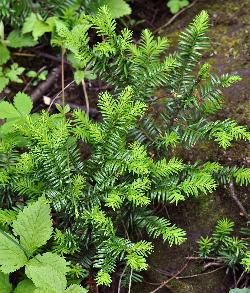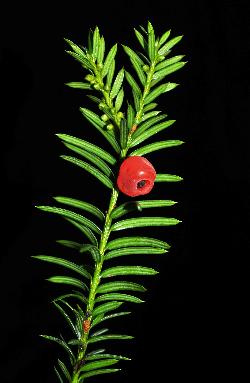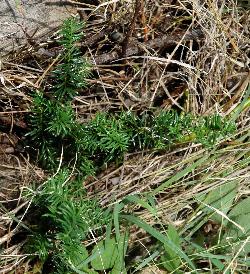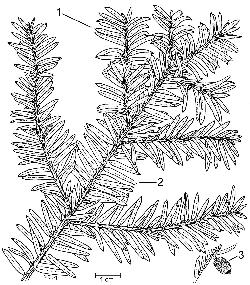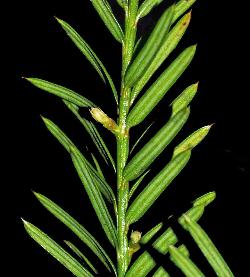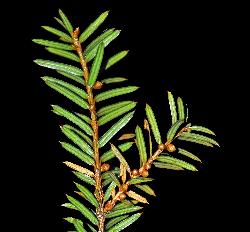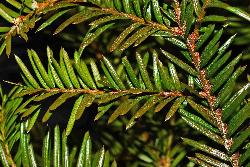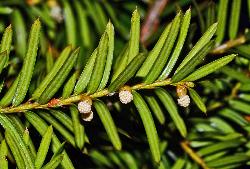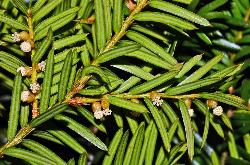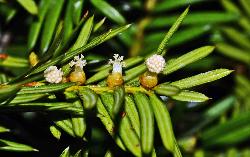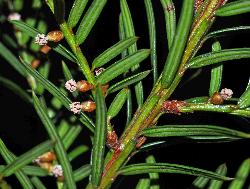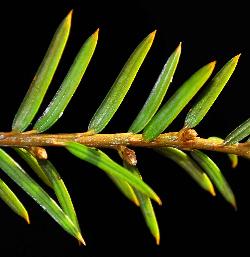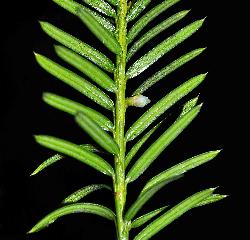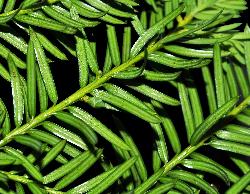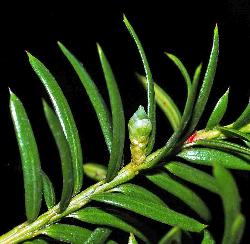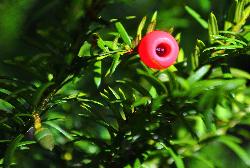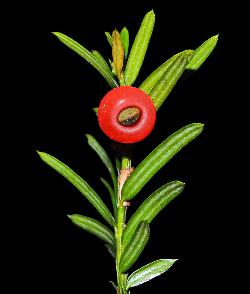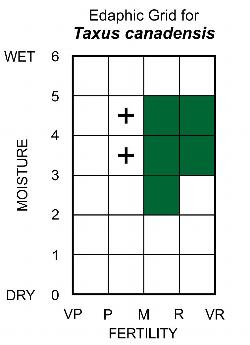Fr: if du Canada, buis du sapin
IA: assiuashiku
Taxaceae - Yew Family
Note: Numbers provided in square brackets in the text refer to the image presented above; image numbers are displayed to the lower left of each image.
General: A low evergreen coniferous shrub, rarely more than 1.5 m tall in our area, with numerous, graceful, spreading branches; colonies form vegetatively through layering of branches. Canada yew is a shade-tolerant species, primarily found in closed-canopy rich forests [1-4]. Leaves, stems, and seeds contain taxine, a poisonous alkaloid used in the production of anti-cancer drugs (e.g., Paclitaxel, Taxol). Canada yew shrubs provide cover, while the red berry-like arils [5] provide food for a variety of small mammals and birds. Seeds and wilted needles are poisonous to humans, horses, and cattle, but not to moose, which are reported to prefer Taxus as browse (Sullivan 1993). This preference has the most impact on Canada yew in Labrador, where plants in the few populations located during rare plant surveys of the Lower Churchill River Valley were found to be heavily browsed by moose (Minaskuat Ltd. 2007), with plants pruned back to about 15 cm in height [6].
Key Features: (numbers refer to the illustration [7])
1. Needles are flat and flexible, with a soft pointed apex and a single prominent vein beneath.
2. Needles appear 2-ranked due to twisting or bending of the decurrent petioles.
3. The naked seed is surrounded by a fleshy red aril, open at one end.
Stems/twigs: Young twigs and branches are green, glabrous, flexible, and marked persistent decurrent leaf bases; older stems are woody with thin reddish-brown bark.
Needles: Evergreen, simple, spirally arranged, with short narrow petioles attached to wider and flattened pads that are decurrent along the stem; needles are arranged in flat planes due to twisting of the petioles to either side of the branches [8-10]. Needles are linear, flat, soft, and 1-2.5 cm long by 1-2.5 mm wide. The upper needle surface is dark green, although young shoots initially have yellowish green needles; the lower surface is paler with a single prominent vein, bordered on each side by a stomatal band composed of parallel rows of minute stomates. Needle margins are entire and curve under slightly (barely revolute); needles end in an abrupt, sharply pointed (mucronate) soft tip. During winter, the foliage becomes bronzed on the upper surface [10].
Reproductive structures/cones: Unisexual, plants monoecious, with separate male and female reproductive structures (strobili) borne on the same shrub. Strobili are situated on the under surface of branches in the needle axils. The small male (staminate) strobilus is composed of a stalked globose cluster of 8-10 stamens borne in a cup-shaped involucre of small thin bracts [11-14]. Images 11 and 12 show male strobili before and after shedding pollen. Female strobili are reduced to a single small ovule (the embryonic seed) subtended by a few bracts [15-18]. Pollination (by wind) and fertilization occur in the early spring. The mature seed is hard, ovoid, slightly flattened, olive-green to brown, and surrounded by a fleshy cup-shaped red aril, 5-10 mm long, which is open at one end [19-23]. Yew arils are edible but slimy (mucilaginous); all other parts of the plant, including the seeds, are considered toxic. Dispersal of the seeds is primarily by birds (endozoochory).
Ecology and Habitat: Canada yew is most abundant on moist rich sites, particularly on soils underlain by limestone, and occurs sporadically on wet nutrient-poor bog forests. Individual patches may increase following cutting, but it does not rapidly expand to cover large areas. Moose browsing frequently decreases its cover, but plants recover if browsing is relaxed. Canada yew is not fire adapted and rarely found on burns or recovering black spruce forests.
Edaphic Grid: See image [24]: the Edaphic Grid for Taxus canadensis.
Forest Types: Canada yew is most commonly found in the following forest types:
Abietum dryopteretosum (Dryopteris-Balsam Fir Forest Subassociation)
Abietum gaultherietosum (Gaultheria-Balsam Fir Forest Subassociation)
Abietum rubetosum (Rubus-Balsam-Fir Forest Subassociation)
Abietum taxetosum (Taxus-Balsam Fir Forest Subassociation)
Betuletum-rubetosum (Rubus-Birch Forest Subassociation)
Kalmio-Piceetum taxetosum (Taxus-Kalmia-Black Spruce Forest Subassociation)
Osmundo-Piceetum (Osmunda-Black Spruce Fen Subassociation)
Succession: Canada yew is a shade-tolerant species that does best in mature closed-canopy forests, although it can persist in the partial shade of riverbanks. In Newfoundland, it rarely exceeds 10% cover in the understorey of mature forests. Pimlott (1963) observed that Canada yew can be eliminated in areas of high moose density. Similar conclusions have been made on Isle Royale in Lake Superior by Risehoover and Maass (1987). Thompson et al. (1992) recorded higher densities within exclosures in Central Newfoundland but the results were not statistically conclusive.
Canada yew can reproduce by seed, but can also spread slowly through branch layering. While small patches can persist on cutovers, it is not invasive; instead, it spreads very slowly through vegetative layering. It is not adapted to fire (Sullivan 1993) and it is rarely encountered in black spruce forests arising from fire, but can occur sporadically on black spruce forests on shallow limestone bedrock (Damman 1963).
Distribution: Canada yew is native to boreal northeastern North America, with a Canadian range that extends from Newfoundland to the southeastern corner of Manitoba (Hills 1993). Within the Province, it occurs throughout insular Newfoundland, with a small disjunct population in central Labrador. In the United States, it occurs from Maine west to Minnesota and southeast to Virginia, with a few disjunct populations in Appalachian States (Hills 1993).
Similar Species: Young regen of balsam fir (Abies balsamea (L.) Mill.) may be mistaken for Canada yew. Both balsam fir and Canada yew have soft needles arranged in flat planes, but fir has blunt-tipped needles attached directly to the twig by flat rounded bases that leave a circular scar when they fall. In contrast Canada yew needles have short distinct petioles and bases that are decurrent, as well as softly pointed tips. Also, balsam fir is resinous, while the wood of Canada yew lacks resin ducts.




